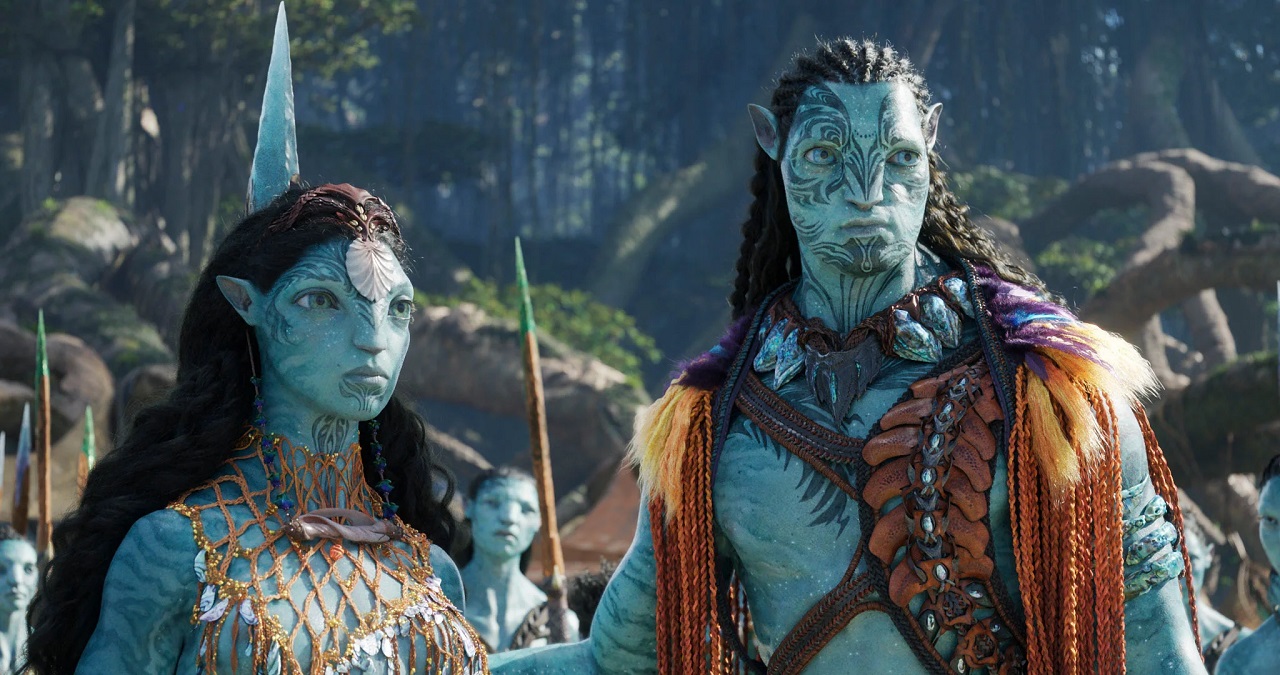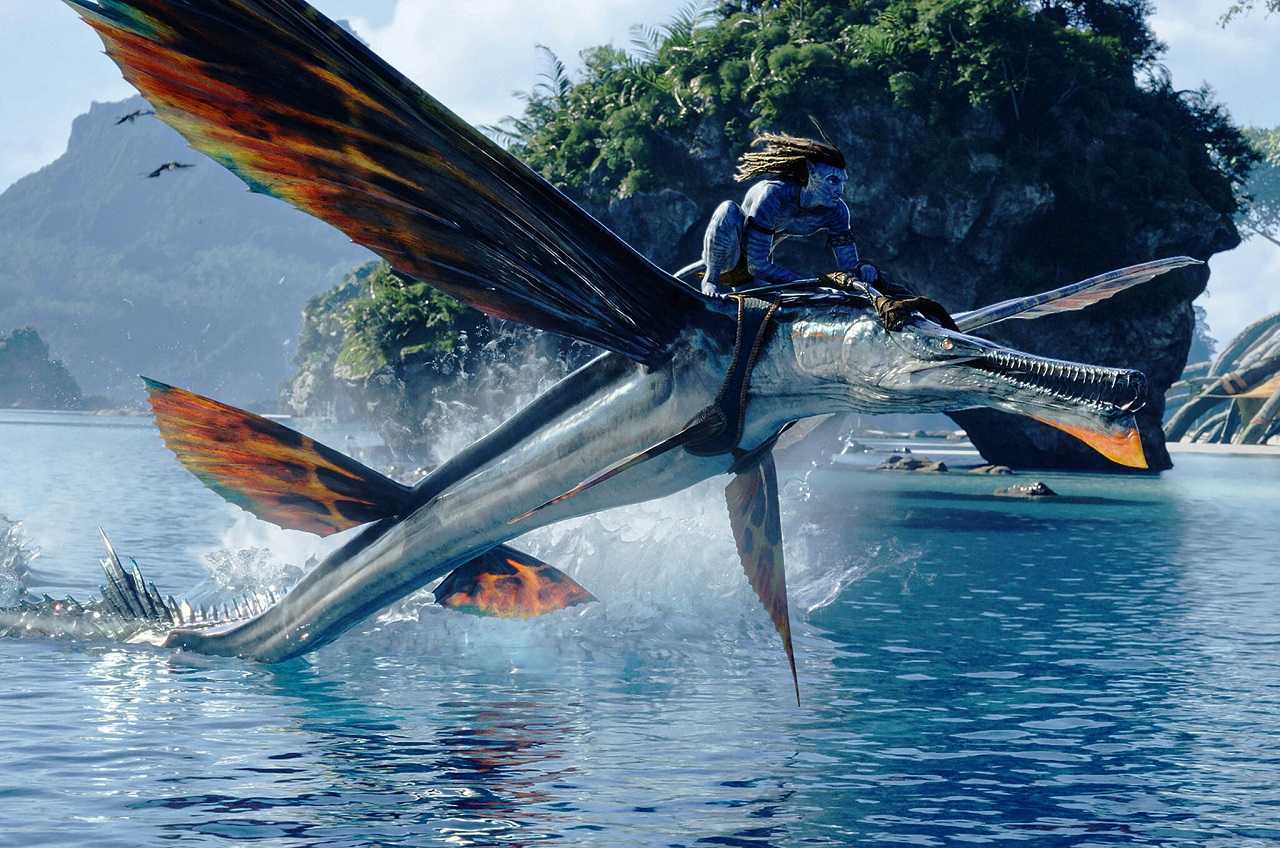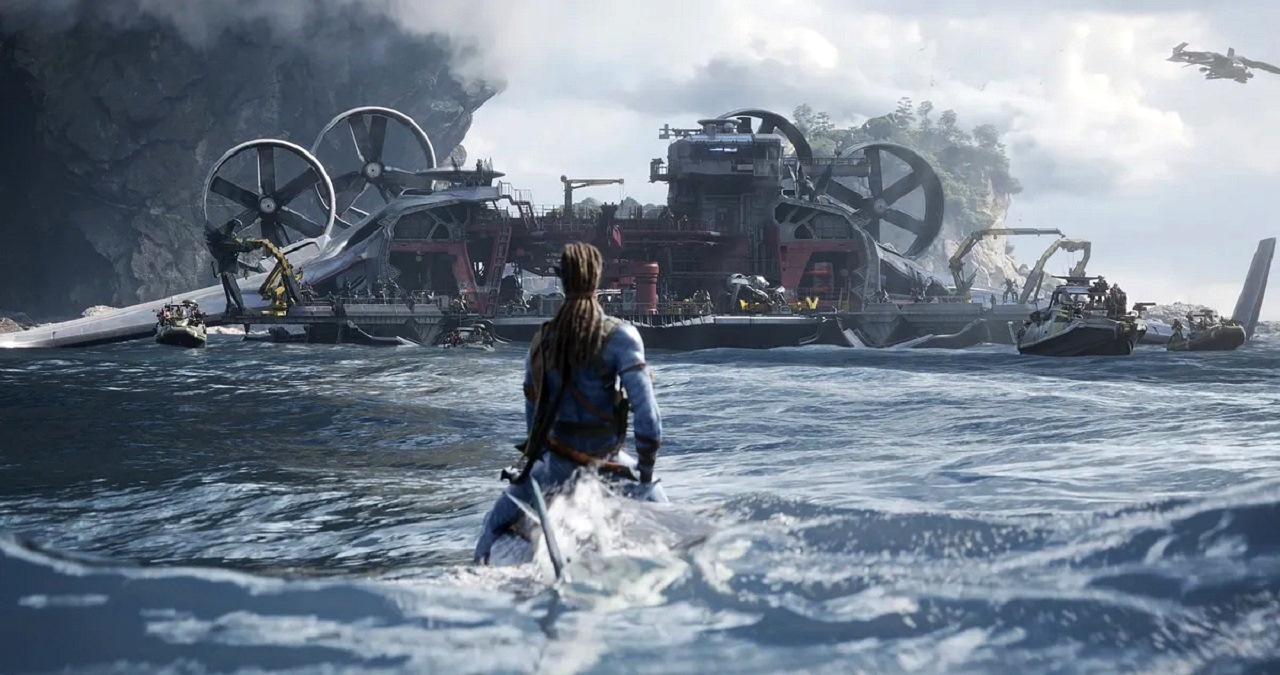USA. 2022.
Crew
Director – James Camron, Screenplay – James Cameron, Rick Jaffa & Amanda Silver, Story – James Cameron, Josh Friedman, Rick Jaffa, Shane Salerno & Amanda Silver, Producers – James Cameron & Jon Landau, Photography (3D) – Russell Carpenter, Music – Simon Franglen, Senior Visual Effects Supervisor – Joe Letteri, Lightstorm Visual Effects Supervisor – Richard Baneham, Visual Effects – Industrial Light & Magic (Supervisor – David Vickery) & Weta FX (Senior Visual Effects Supervisor – Eric Saindon, Senior Animation Supervisor – Daniel Barrett, Visual Effects Supervisors – Pavani Rao Boddapati, Dan Cox, Nick Epstein, Mark Gee, Ken McGaugh, Sergei Nevshupov, Wayne Taz Stables & Stefan Unterfranz), Live Action Creature Effects Supervisor – Steve Ingram, Character Design – Legacy Effects (Supervisor – John Rosengrant), Production Design – Dylan Cole & Ben Procter. Production Company – Lightstorm Entertainment/TSG Entertainment.
Cast
Sam Worthington (Jake Sully), Zoe Saldana (Neytiri), Stephen Lang (Quaritch), Sigourney Weaver (Kiri), Jamie Flattters (Neteyam), Jack Champion (Spider), Cliff Curtis (Tonowari), Brian Dalton (Loak), Bailey Bliss (Tseriya), Kate Winslet (Ronal), Edie Falco (General Frances Ardmore), Brendan Cowell (Scoresby), Jemaine Clement (Dr Ian Garvin), Trinity Jo-Li Bliss (Tuk), Filip Geljo (Aonung), Duane Evans, Jr (Rotxo), Joel David Moore (Norm), CCH Pounder (Mo’at)
Plot
It is sixteen years after the humans were driven off Pandora. Jake and Neytiri have raised three children, as well as adopted two other hybrid children born from the colonists. Their peace is interrupted as Earth ships return to occupy the planet. Among the new contingent is a copy of Miles Quaritch who has had his memories resurrected in a Na’vi hybrid body. He leads a team of other Na’vi-human hybrids in an effort to hunt down Jake. Miles targets Jake’s children after they mount an attack on a maglev train. Jake sees the only safe option is he, Neytiri and the children abandoning the forest and seeking refuge elsewhere. They set out, eventually coming to the village of the Metkayina sea people, who agree to grant them sanctuary. There they set about learning the ways of the Metkayina sea-based culture and their communion with the giant whale-like Tulkun. However, Quaritch is determined to track Jake down. After brutalising the other Metkayina villages fails to work, Quaritch and his men begin killing the Tulkun and leaving their slaughtered bodies, knowing this will draw Jake out.
James Cameron has been at the forefront of the genre ever since dazzling audiences with his second film The Terminator (1984). From there, Cameron went on to make hugely successful A-budget efforts such as Aliens (1986), The Abyss (1989) and Terminator 2 Judgment Day (1991). That was before his epically budgeted version of Titanic (1997) ended up being a No 1 box-office hit and winning Cameron a Best Picture and Best Director at the Academy Awards. This was something that Cameron topped with the even bigger success of Avatar (2009), which became the highest grossing film in history. (See below for James Cameron’s other films).
Cameron has an obsessiveness with fine-tuning the technology that rivals the perfectionism of Stanley Kubrick. While any other director would have quickly dashed off an Avatar sequel within a couple of years of the original, Cameron spent thirteen years working with Peter Jackson’s Weta effects team perfecting the process. (He also spent twelve years working on Avatar following Titanic). With another three Avatar sequels purportedly in the pipeline, you are given cause to wonder at this rate of production whether the 68 year-old Cameron will manage to get them all made within his lifetime.
The question that I had before sitting down to watch Avatar: The Way of Water is whether James Cameron would be able to repeat the phenomenon a second time. Avatar was the No 1 film of all time but that was thirteen years ago and audiences are notorious for their goldfish attention spans in this era of social media. The film was widely acclaimed but seemed a phenomenon that was very 2009 that was over and done with and then facing a backlash of people who called it overrated and a letdown. In retrospect, the biggest influence that Avatar held was creating a craze for 3D Movies with every studio quickly rushing to churn out 3D films in the belief that that was what made the film a success. By the mid-2010s, the glut of unnecessary 3D films with over-hiked prices was switching audiences off, while the pandemic welcomely seemed to kill 3D off fairly much for good.

The good news for James Cameron is that audiences did respond to Avatar: The Way of Water in the same ways they did the first film. As of the current writing, Avatar still remains the No 1 box-office hit of all time having earned $2.9 billion. Avatar: The Way of Water sits in third place with $2.3 billion and Titanic in fourth place with $2.25 billion. Cameron has three of the top four spots with the No 2 spot going to Avengers: Endgame (2019).
Revisiting the world of Pandora a second time makes you realise some things that escaped you the first time. Like how the Na’vi seem to adopt very human gender roles – the boys fight and are seen as protectors of the girls, the women do housework, while the Na’vi seem to have the same taboos against bare-breastedness that Westernised human societies do and the women wear modest bikini tops. You are also aware that this film spends even more time than the first film among the Na’vi with the humans very much as secondary characters so that what you are watching is in fact now more than three-quarters of an animated film.
The introduction of the Metkayina also makes you realise just how much James Cameron is basing the peoples of Pandora on terrestrial societies. The Na’vi are like Amazonian Indians, while the scenes where they raid a maglev train would be not out of place in a Western with them as American Indians. Equally, the Metkayina seem based on Polynesian culture – you get the impression that during James Cameron’s time spent in New Zealand he made a visit to a <i<marae and incorporated Maori ta moko (facial tattoos) into the skins of the Metkayina and even the whales, while the Metakayina even seem on the verge of breaking into a haka at one point. (Cameron also employs several Maori actors among his supporting cast).

You also become aware of how the film falls very much into black-and-white divides. Humanity seems to be a stand in for Western industrial culture. Your immediate comparisons are to the conquest of the American West or the Spanish Conquistadors – the scene where they slaughter one of the whales for its brain fluid cannot help but compare to the slaughter of the American bison. The humans come backed by massive military force while the natives are armed with only spears and bow and arrow. Cameron’s sympathy is very much with the native cultures and their mystic communion with the planet. On the other hand, there is also Cameron the director fascinated with technology where he cannot help decking out the scenes of the soldiers in action with nifty inventions – I particularly liked the scenes where we first meet Edie Falco and she walks around in a giant waldo, even drinking a cup of coffee. Or else the scenes aboard a massive military hydrofoil where the soldiers go into action using crab-shaped submersibles.
I also had a difficulty with the sleight of hand that Cameron pulls on us where we get the first couple of minutes in subtitled Na’vi language before he switches and has them then speak English. I didn’t mind this as it means you are watching the amazing world up on screen rather than spending your time reading subtitles. However, listening to the Na’vi using very contemporary terms like calling one another ‘bro’, ‘bitch’ and ‘perv’, or coming out with terms like “are we there yet?” kept jerking me out of my suspension of disbelief in such a beautifully created world.
The first film was essentially Dances With Wolves (1990) relocated to another planet with Na’vi standing in for native Americans. Much of the first film was about Cameron exploring the unique world he had created and its exotic flora and fauna. Here by contrast, almost the first hour of The Way of Water is taken up with the introduction of Jake’s children and the return of Quaritch, before we get to the water world. What is lacking here is the scenes in Avatar where Cameron opened the world of Pandora up to us through Jake’s eyes, These are just action scenes – engaging and all as they are, they lack quite the same magic as the ones in the first film did.

On the other hand, once we reach the realm of the Metkayina, Cameron silences all doubters. Where the first film was Cameron exploring the surface world, this is him exploring the water world. (It should also be noted that Cameron is a diving aficionado and has made several documentaries on the subject so this seems like a natural next step for him). There is a stunning beauty as we watch the watch the newcomers exploring the underwater realm, communing with the exotic marine life and taking flight in creatures that are improbably both birds and fish, all of which the film has created for us in the most exquisite detail and colours. Particularly emotional and moving was the scene where Neteyam communes with a giant wounded pariah Tulkun. The results are quite magical.
In the latter scenes, Cameron extends the climactic scenes of Avatar out into a massive battle that takes up over an hour of the concluding sections of the film. And when it comes to these scenes, Cameron delivers all that we expect. Almost all of this time is taken up by the massively scaled scenes with the humans hunting the Tulkun and then the Na’vi attack on the hydrofoil and boats. The action has a scale and ingenuity of detail that leaves you cheering. The later scenes with Jake and Quaritch, along with assorted family members, fighting aboard the hydrofoil as it begins sinking and then overturning are Cameron revisiting something of the territory of Titanic. They are scenes where you can see James Cameron, along with the army of technicians at the Weta Workshop and Industrial Light and Magic, pushing the technology as far as it can go until the effects become an art form unto themselves. The results are enthralling and it is here that Avatar: The Way of Water delivers all that you want it to.
James Cameron’s other films are:– Piranha II: Flying Killers/Piranha II: The Spawning (1981), The Terminator (1984), The Abyss (1989), Terminator 2: Judgment Day (1991), True Lies (1994) and Titanic (1997). Cameron has also written the millennial virtual reality film Strange Days (1995), which was directed by his wife Kathryn Bigelow, and wrote/produced the manga adaptation Alita: Battle Angel (2019) and Terminator: Dark Fate (2019), as well as produced the near future tv series Dark Angel (2000-2), the remake of Solaris (2002), the rock diving survival film Sanctum (2011) and Cirque du Soleil: Worlds Away (2012). He also hosts and produces the tv documentary series AMC Visionaries: James Cameron’s The Story of Science Fiction (2018).
Cameron co-writes the script with the writing duo of husband and wife Rick Jaffa and Amanda Silver who have also delivered the scripts for Planet of the Apes reboot trilogy Rise of the Planet of the Apes (2011), Dawn of the Planet of the Apes (2014) and War of the Planet of the Apes (2017), plus Eye for an Eye (1996), the monster movie The Relic (1997), Jurassic World (2015), In the Heart of the Sea (2015) and Mulan (2020). Silver on her own wrote The Hand That Rocks the Cradle (1992).
(Winner in this site’s Top 10 Films of 2022 list. Winner for Best Special Effects and Best Production Design, Nominee for Best Director (James Cameron) at this site’s Best of 2022 Awards).
Trailer here

